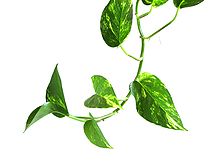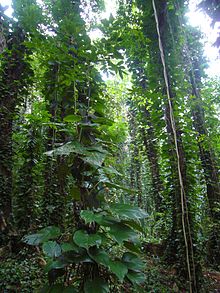- Epipremnum aureum
-
Epipremnum aureum 
A variegated cultivar of Epipremnum aureum Scientific classification Kingdom: Plantae Division: Angiosperms (unranked): Monocots Order: Alismatales Family: Araceae Subfamily: Monsteroideae Tribe: Monstereae Genus: Epipremnum Species: E. aureum Binomial name Epipremnum aureum
(L.) Engl.Epipremnum aureum, also known as the Pothos (once classified under the genus Pothos), Money Plant, Silver Vine, Centipede tongavine, Devil's Ivy and Solomon Islands' Ivy, is an aroid native to southeastern Asia (Malaysia, Indonesia) and New Guinea. It is sometimes mistakenly labeled as a Philodendron in plant stores.
It is an epiphyte growing to 20 m tall, with stems up to 4 cm diameter, climbing by means of aerial roots which hook over tree branches. The leaves are evergreen, alternate, heart-shaped, entire on juvenile plants, but irregularly pinnatifid on mature plants, up to 100 cm long and 45 cm broad (juvenile leaves much smaller, typically under 20 cm long). The flowers are produced in a spathe up to 23 cm long. This plant produces trailing stems when it climbs up trees and these take root when they reach the ground and grow along it. The leaves on these trailing stems grow up to 10cm long and are the ones normally seen on this plant when it is cultivated as a pot plant.
Contents
Cultivation and uses
It is a popular houseplant with numerous cultivars selected for leaves with white, yellow, or light green variegation. It is often used in decorative displays in shopping centers, offices, and other public locations largely because it is a very hardy plant that requires little care and is also attractively leafy. It is also efficient at removing indoor pollutants such as formaldehyde, xylene, and benzene.[1] A study found that this effect lessened the higher the molecular weight of the polluting substance.[2]
As a houseplant it can reach a height of two meters or more, given suitable support. For best results it requires medium indirect light; bright light is tolerated, but lengthy spells of direct sun will scorch the leaves. The plant prefers a temperature of between 17 to 30 °C (63 to 86 °F). Generally it only needs water when the soil begins to feel dry to the touch. For best results a liquid fertilizer can be added in spring, and they should be repotted every couple of years. However, this is a robust plant that can stand a very high degree of abuse. It will grow hydroponically quite readily.
The plant is listed as "toxic to cats, toxic to dogs" by the ASPCA, because of the presence of insoluble raphides. Care should be taken to ensure the plant is not consumed by house pets or children. Symptoms may include oral irritation, vomiting, and difficulty swallowing.[3]
Invasive Species
This vine can become a highly invasive species when introduced into tropical countries where it is not native. In Sri Lanka it overgrows several hectares of the Udawatta Kele Sanctuary in Kandy.[4] Having no natural enemies, it completely overgrows the forest floor as well as the trunks of trees, causing severe ecological disruption.
It also invades the Kurulukele Forest Reserve in Kegalla and other places where it has been planted as a decorative plant, or to hold steep banks along roads. In Florida it can also be an invasive species.[5]
External links
- Pothos Production Guide - discusses care of this plant
- TED video - Kamal Meattle on How to Grow Your Own Fresh Air slides
See also
- Jade plant (also referred to as "money tree")
- Annual honesty (also referred to as "money plant")
References
- ^ Wolverton, B. C. How To Grow Fresh Air, Penguin Books, New York, 1997.
- ^ Ayako Sawada, Takashi Oyabu, Purification characteristics of pothos for airborne chemicals in growing conditions and its evaluation, Atmospheric Environment, Volume 42, Issue 3, January 2008, Pages 594-602, ISSN 1352-2310, DOI: 10.1016/j.atmosenv.2007.10.028.
- ^ "Devils Ivy". ASPCA.org. http://www.aspca.org/pet-care/poison-control/plants/devils_ivy.html. Retrieved 2009-03-11.
- ^ "'W. De Costa, H. Hitanayake and I. Dharmawardena, “A Physiological Investigation into the Invasive Behaviour of Some Plant Species in a Mid-Country Forest Reserve in Sri Lanka”". JNSFSL, 2001, 29 (1 & 2):35–50. http://thakshana.nsf.ac.lk/pdf/JNSF26-34/JNSF29_1&2/JNSF29_1&2_35.pdf. Retrieved 2009-03-11.
- ^ "PLANTS Profile Epipremnum pinnatum". USDA.org. http://www.plants.usda.gov/java/profile?symbol=EPPI. Retrieved 2009-03-11.
Categories:- Araceae
- Flora of Asia
- House plants
Wikimedia Foundation. 2010.


